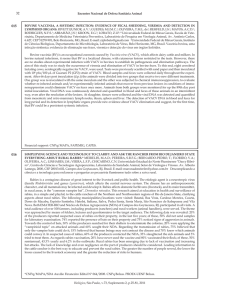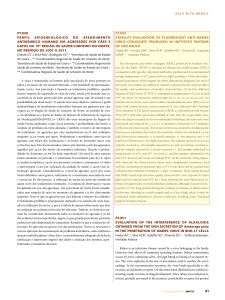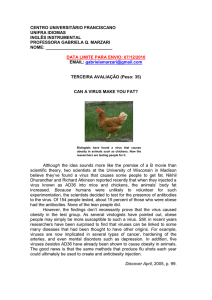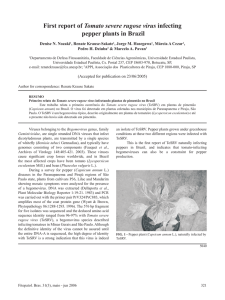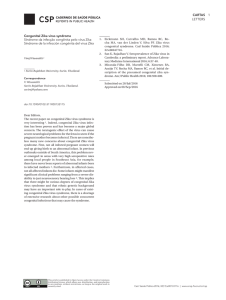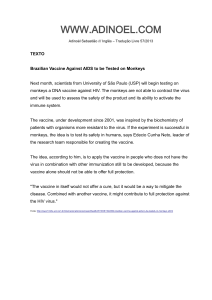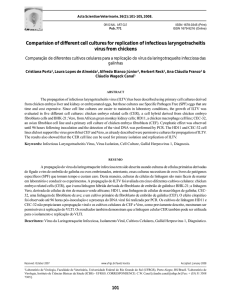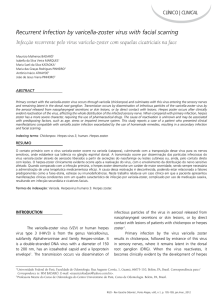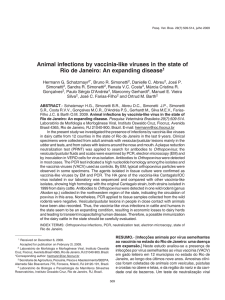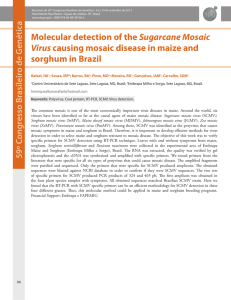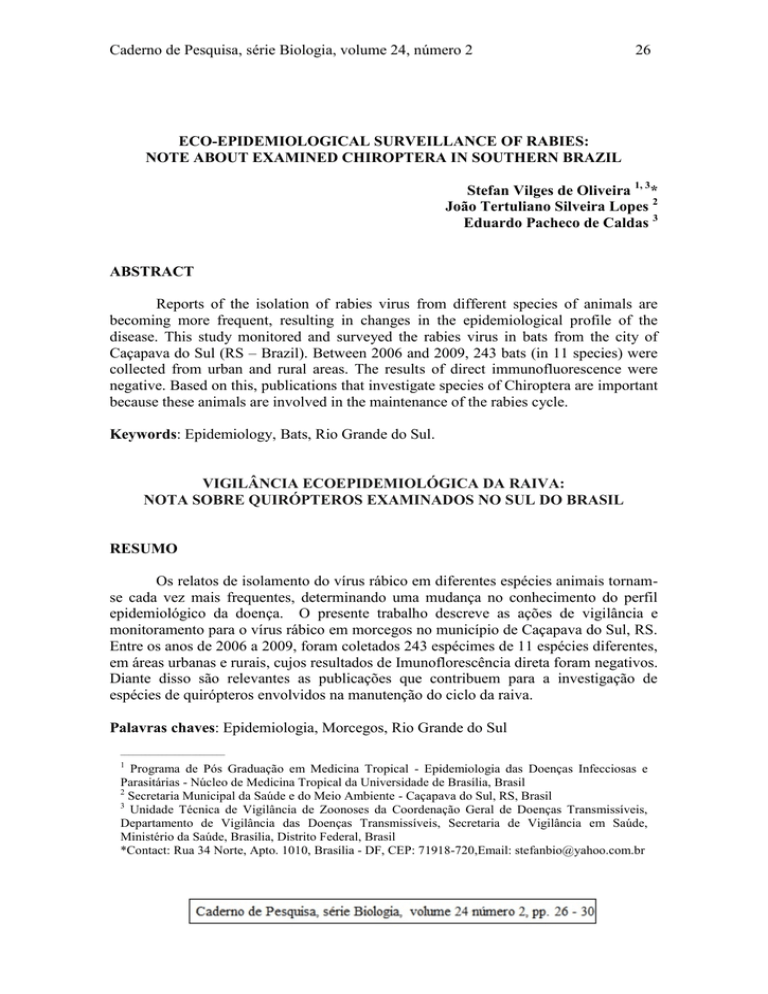
Caderno de Pesquisa, série Biologia, volume 24, número 2
26
ECO-EPIDEMIOLOGICAL SURVEILLANCE OF RABIES:
NOTE ABOUT EXAMINED CHIROPTERA IN SOUTHERN BRAZIL
Stefan Vilges de Oliveira 1, 3*
João Tertuliano Silveira Lopes 2
Eduardo Pacheco de Caldas 3
ABSTRACT
Reports of the isolation of rabies virus from different species of animals are
becoming more frequent, resulting in changes in the epidemiological profile of the
disease. This study monitored and surveyed the rabies virus in bats from the city of
Caçapava do Sul (RS – Brazil). Between 2006 and 2009, 243 bats (in 11 species) were
collected from urban and rural areas. The results of direct immunofluorescence were
negative. Based on this, publications that investigate species of Chiroptera are important
because these animals are involved in the maintenance of the rabies cycle.
Keywords: Epidemiology, Bats, Rio Grande do Sul.
VIGILÂNCIA ECOEPIDEMIOLÓGICA DA RAIVA:
NOTA SOBRE QUIRÓPTEROS EXAMINADOS NO SUL DO BRASIL
RESUMO
Os relatos de isolamento do vírus rábico em diferentes espécies animais tornamse cada vez mais frequentes, determinando uma mudança no conhecimento do perfil
epidemiológico da doença. O presente trabalho descreve as ações de vigilância e
monitoramento para o vírus rábico em morcegos no município de Caçapava do Sul, RS.
Entre os anos de 2006 a 2009, foram coletados 243 espécimes de 11 espécies diferentes,
em áreas urbanas e rurais, cujos resultados de Imunoflorescência direta foram negativos.
Diante disso são relevantes as publicações que contribuem para a investigação de
espécies de quirópteros envolvidos na manutenção do ciclo da raiva.
Palavras chaves: Epidemiologia, Morcegos, Rio Grande do Sul
_________________________
1
Programa de Pós Graduação em Medicina Tropical - Epidemiologia das Doenças Infecciosas e
Parasitárias - Núcleo de Medicina Tropical da Universidade de Brasília, Brasil
2
Secretaria Municipal da Saúde e do Meio Ambiente - Caçapava do Sul, RS, Brasil
3
Unidade Técnica de Vigilância de Zoonoses da Coordenação Geral de Doenças Transmissíveis,
Departamento de Vigilância das Doenças Transmissíveis, Secretaria de Vigilância em Saúde,
Ministério da Saúde, Brasília, Distrito Federal, Brasil
*Contact: Rua 34 Norte, Apto. 1010, Brasília - DF, CEP: 71918-720,Email: [email protected]
Caderno de Pesquisa, série Biologia, volume 24, número 2
27
INTRODUCTION
Rabies is a zoonosis caused by a virus and occurs naturally in domestic and wild
species in the orders Carnivora and Chiroptera (called reservoirs) (Kotait et al., 2007).
The involvement of bats in the transmission of the rabies virus was first suggested
in the last century by Carini (1911), and hematophagous bats (especially Desmodus
rotundus) are reservoirs of variant 3 of this virus. In 2004 and 2005, D. rotundus was
considered the main vector of human rabies in Latin America, and Brazil had the largest
number cases (Kotait et al., 2007).
In Rio Grande do Sul, rabies has occurred in an endemic form for decades, with
cases in cattle, horses and pigs, which are caused by variant 3 (Governo do Estado,
2010).
In recent years, reports of isolating rabies from bats with different feeding habits
(insectivores, frugivores, omnivores, pollenivores and piscivores) have become more
common throughout the world (Uieda et al., 1995; 1996), and many of these are
denominated as “lyssavirus” emergent (Fooks, 2004).
The first reports of the presence of the rabies virus in non-hematophagous bats in
Rio Grande do Sul were in 1965 (Bauer & Crusius, 1965). Among these bats, Tadarida
brasiliensis (morceguinho das casas), which is in the family Molossidae, tested positive
for a type of variant 4.
In 2001, a case of rabies was registered in a domestic cat, which was infected by a
virus compatible with the variant 4 virus isolated from Tadarida brasiliensisSchaefer et
al., 2002). In 2007 a dog died in the Tapes municipality and a rabies analysis confirmed
that it was also infected with variant 4 (Caldas et al., 2007).
With the population of bats increasing in urban areas, knowledge of the various
risk factors related to the epidemiology of rabies in different bat species is an important
tool to control this disease in herbivores, pets and humans (Bredt et al., 1996). Based on
this perspective, the objective of this study was to indentify species of bats involved in
maintaining the rabies cycle in the municipality of Caçapava do Sul, RS.
MATERIALS AND METHODS
The municipality of Caçapava do Sul (30°31'11' S, 53°29'16'' W), in Rio Grande
do Sul, is part of the Pampa biome and the zoogeographic region of the Província
Pampeana da Serra do Sudeste.
From 2006 to 2009 bats were randomly collected in urban and rural areas of the
municipality. To collect the bats, mist nets (11 × 3 m and 10 ×3 m) were mounted next
to the exits of the places where the bats live, near feeding areas and where they fly.
Individuals were also collected directly from the shelters where they live using
tweezers, nets and leather gloves. In addition, bats that were found (dead or alive), in
atypical locations or inside houses, were examined. The biometric data was recorded on
field sheets and the species were identified using keys (Vizotto & Tadedei, 1973). The
collections and euthanasia were authorized by IBAMA (permit number 014/2006 DITEC) and the entire carcasses were shipped frozen to the diagnostic laboratory at the
Instituto de Pesquisas Veterinárias Desidério Finamor, in the city of Eldorado do Sul
(RS). The brain tissue was examined using direct immunofluorescence (DIF).
Caderno de Pesquisa, série Biologia, volume 24, número 2
28
RESULTS AND DISCUSSION
During the study 243 individuals were examined, which belonged to 11 species
and had different feeding habitats. Of the total, 45% were collected in shelters in
houses, 6% were found in atypical locations, 10% in abandoned buildings, 21% in caves
and 18% were captured in mist nets. All of the specimens analyzed tested negative for
rabies using DIF (Table 1).
Table 1. Number of specimens collected, families/species, feeding guilds and collection
location.
Num. Families/Species
Feeding Guild
Collection Location
Vespertilionidae
7
Myotis nigricans
insectivore
shelter
15
Eptesicus brasiliensis
insectivore
shelter
50
Histiotus velatus
insectivore
shelter
2
Histiotus velatus
insectivore
outside of shelter
Molossidae
25
Tadarida brasiliensis
insectivore
shelter
9
Tadarida brasiliensis
insectivore
outside of shelter
12
Molossus molossus
insectivore
shelter
2
Molossus molossus
insectivore
outside of shelter
1
Molossus rufus
insectivore
outside of shelter
Phyllostomidae
5
Glossophaga soricina
pollenivore/nectivore
mist net
23
Glossophaga soricina
pollenivore/nectivore
shelter
35
Sturnira lilium
pollenivore/nectivore
mist net
5
Artibeus fimbriatus
frugivores
mist net
51
Desmodus rotundus
hematophagous
shelter
1
Chrotopterus auritus
carnivore
shelter
243
3 Families - 11 species
Of the eleven species examined in the study, ten were already described as
reservoirs of the rabies virus in Brazil; the only exception was Sturnira lilium (Sodré et
al., 2010). Data from Ministry of Health showed a change in epidemiology of rabies in
Brazil, in recent years. The significant increase of notifications of rabies in bats, as well
as seeking medical attention due to attacks, warn of the risk of infection and illness
(Wada et al., 2011).
Although research has not identified species of bats positive, we cannot rule out
the possibility of movement of the virus in this area. Studies by several researchers
present controversial results related to the amount of infection, which could be related to
variations in sampling techniques as well as collection locations (Uieda et al., 1995;
1996).
In bats captured in caves the amount of infection is generally 0.1 to 0.5% (Uieda
et al., 1996). In a study in the northeastern region of the state of São Paulo, which used
the same methodology, the amount of infection was 1.2% (Queiroz et al., 2009). Souza
et al. (2005) found, after eight years of epidemiological surveillance for rabies in the
Caderno de Pesquisa, série Biologia, volume 24, número 2
29
municipality of Botucatu (SP), in 1480 captured bats, low positive results for the rabies
virus; only three had rabies, one hematophagous and two insectivorous bats.
Uieda et al. (1995) stressed the importance of being suspicious about bats that are
found in atypical places, a fact that has been confirmed in insectivorous bats. Although
individuals that exhibit abnormal behavior are highly suspect, it is important to note that
specimens captured in their shelters, which appeared healthy, have been diagnosed as
positive (Uieda et al., 1996). This suggests that it is necessary to search for the virus in
animals with no apparent symptoms. We believe that with a greater amount of sampling
it will be possible to detect the rabies virus, due to the low number of positive results
shown in asymptomatic bats.
As the literature reports more cases of infected bats in multiple environments, the
surveillance of these animals is becoming an urgent issue for public health services.
Ecological alterations of wild ecosystems have contributed significantly to an
increase in colonies of non-hematophagous bats in urban environments. We emphasize
that the destruction of colonies is not an effective method to control the virus in
different species of bats. In fact, it is necessary to invest in studies to learn more about
the dynamics of the rabies virus in different species. To further understand this
situation, it is also important to clarify the role of the bats, and their different feeding
habits, in the epidemiology of this zoonosis.
REFERENCES
BAUER, A. G.; CRUSIUS, V. A. Isolamento do vírus rábico de morcego insetívoro na
cidade de São Leopoldo no Rio Grande do Sul. In: Conferência Anual da Soc. Vet. do
RS. 1965; 4. Porto Alegre, p. 95. 1965.
BREDT A.; ARAUJO, F. A. A.; CAETANO-JR., J.; RODRIGUES, M. G. R.;
YOSHIZAWA, M.; SILVA, M. M. S.; HARMANI, N. M. S.; MASSUNAGA, P. N. T.;
BURER, S. P.; PORTO, V. A. R.; UIEDA, W. Morcegos em áreas urbanas e rurais:
manual de manejo e controle. Brasília, FNS. 117 pp. 1996.
CALDAS, E.; PREDEBON, J.; DIEDRICH, J.; FARINATTI, A.; BARRETO, N.;
CAMPIELO, P.; KESSLER, S.; MAGOGA, E.; IRIGARAY, G.; CARRIERI, M. L.;
BATISTA, H.; ROSA, J.; FERREIRA, J. C.; ROEHE, P. Descrição do achado de raiva
canina por vírus rábico de origem em morcego não hematófago Tadarida brasiliensis.
Bol. Epid. 9, (2): 1 - 3. 2007.
CARINI, A. Sur une grande epizootie de rage. Ann. I'Inst. Past. 25: 843-6. 1911.
FOOKS, A. R. The challenge of new and emerging lyssaviruses. Expert Rer. Vac. 3 (4):
333-336. 2004.
Governo do Estado (Rio Grande do Sul, BR). Secretaria da Saúde. (2010) Porto Alegre
(Internet). (acessado em 17 de janeiro de 2010). Disponível em:
http://www.saude.rs.gov.br/wsa/portal/index.jsp?menu=servicos&cod=22246.
Caderno de Pesquisa, série Biologia, volume 24, número 2
30
KOTAIT, I.; CARRIERI, M.L.; CARNIELI, P. J.; CASTILHO, J. G.; OLIVEIRA, R.
N.; MACEDO, C. I.; FERREIRA, K. C. S.; ACHKAR, S. M. Reservatórios silvestres
do vírus da raiva: um desafio para a saúde pública. Bol. Epid. Paul. SP. 4 (40) : 1-10.
2007.
QUEIROZ, L. H.; CARVALHO, C.; BUSO, D. S.; FERRARI, C. I. L.; PEDRO, W. A.
Perfil epidemiológico da raiva na região Noroeste do Estado de São Paulo no período de
1993 a 2007. Rev. da Soc. Bras. de Med. Trop. 2009; 42(1): 9-14.
SCHAEFER, R.; CALDAS, E. P.; SCHMIDT, E.; KING, A.; ROEHE, P. M. First case
of cat rabies in eleven years in Southern Brazil was caused by a virus of bat origin,
distinct from urban rabies virus. Vet. Rec. Ingl. 150 (7): 216. 2002.
SODRÉ, M. M.; GAMA, A. R.; ALMEIDA, M. F. Updated list of bat species positive
for rabies in Brazil. Rev. Inst. Med. Trop. SP. 52 (2): 75-81. 2010.
SOUZA, L. C.; LANGONI, H.; SILVA, R. C.; LUCHEIS, S. B. Vigilância
Epidemiologia da raiva na região de Botucatu-SP: Importância dos Quirópteros na
manutenção do vírus na natureza. ARS Vet., Jab. SP. 21 (1): 62-68. 2005.
UIEDA, W.; DEBERALDINI, E. R. Papel do morcego hematófago Desmodus rotundus
na transmissão da raiva. Divul. do Mus. de Cie. Tecn. Ubea/PUCRS 2: 32-37. 2003.
UIEDA, W.; HARMANI, N. M. S; SILVA, M. M. Raiva em morcegos insetívoros do
sudeste do Brasil. Rev. de Sau. Publ. 29: 393-397. 1995.
UIEDA, W.; HAYASHI, M. M.; GOMES, L. H.; SILVA, M. M. Espécies de
quirópteros diagnosticadas com raiva no Brasil. Bol. Inst. Past. 1:17-35. 1996.
VIZOTTO, L. D.; TADDEI, V. A. Chave para determinação de quirópteros brasileiros.
Rev Fac Fil. Cien Let S José R Preto Bol Cien. 1: 1-72. 1973;
WADA, M. Y.; ROCHA, S. M.; MAIA-ELKHOURY, A. N. S. Situação da Raiva no
Brasil, 2000 a 2009. Epidemiol. Serv. Saúde, Brasília 20 (4): 509-518. 2011.

